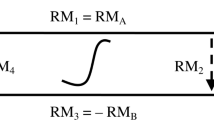Abstract
Pioneer VI was launched into a circumsolar orbit on December 16, 1965, and was occulted by the sun in the latter half of November, 1968. During the occultation period, the 2292-MHz S-band telemetry carrier underwent Faraday rotation due to the interaction of this signal with the plasma and magnetic field in the solar corona. The NASA/JPL 210-ft diameter antenna of the Deep Space Network near Barstow, California, was used for the measurement. The antenna feed was modified for automatic polarization tracking for this experiment.
The measurement results are interpreted with a theoretical model of the solar corona. This model consists of a modified Allen-Baumbach electron density and a coronal magnetic field calculated both from Mount Wilson magnetograph observations using a source surface model and field extrapolations from the Explorer 33 satellite magnetometer. The observations and the calculated rotation show general agreement with respect to magnitude, sense, and timing, suggesting the source-surface model and field extrapolations from 1 AU are a valid technique to obtain the magnetic field in the corona from 4 to 12 solar radii. Variations present can easily be ascribed to density enhancements known to be present in the corona. Longitudinal variations of the density in the corona cannot be obtained from coronagraph observations, and thus a purely radial variation was assumed. An improved fit to the Faraday rotation data is obtained with an equatorial electron density
where R is in solar radii.
The work of W. V. T. Rusch and J. E. Ohlson was supported in part by research sponsored by the Joint Services Electronics Program through the Air Force Office of Scientific Research under Grant AF-AFOSR 69-1622A at the University of Southern California.
The work done by K. H. Schatten was in part supported by the National Academy of Science on a National Research Council postdoctoral fellowship.
The work of J. M. Wilcox was supported in part by the Office of Naval Research under Contract Nonr 3656(26), by the National Aeronautics and Space Administration under Grant NGR 05-003-230, and by the National Science Foundation under Grant GA-1319 at the University of California at Berkeley.
Similar content being viewed by others
References
Altschuler, M. and Newkirk, G. A.: 1969, Solar Phys. 9, 131.
ESSAResearch Laboratories Solar Geophysical Data: 1969a, No. 297, 298, U.S. Department of Commerce, Boulder, Colo.
Evans, J. V. and Hagfors, T.: 1968, Radar Astronomy, McGraw-Hill.
Goldstein, R.M. et al.: 1967, ‘The Superior Conjunction of Mariner IV’, Technical Report 32–1092, Jet Propulsion Laboratory, Pasadena, Calif.
Goldstein, R. M.: 1969, Science 166, 598.
Hollweg, J. V.: 1967, ‘A Statistical Ray Analysis of the Scattering of Radio Waves by an Anisotropically Turbulent, Non-Homogeneous Solar Corona’, Unpublished Ph.D. dissertation, Massachusetts Institute of Technology.
Kaufmann, P., Matsuura, O. T., Mascaro, A. C., and Mendes, A. M.: 1968, Nature 220, 1298.
Kraus, J. D.: 1966, Radio Astronomy, McGraw-Hill.
Laffineur, M., Burnichon, M. L., and Koutchmy, S.: 1969, Nature 22, 461.
Levy, G.S., Sato, T., Seidel, B. L., Stelzried, C. T., Ohlson, J. E., and Rusch, W. V. T.: 1969, Science 166, 596.
Mulhall, B. D. and Thuleen, K. L.: 1969, ‘Conversion of Faraday Rotation Data to Ionospheric Measurements’, Jet Propulsion Laboratory Space Programs Summary Report No. 37–55, Vol. II, Jet Propulsion Laboratory, Pasadena, Calif.
Newkirk, G. A.: 1967, Ann. Rev. Astron. Astrophys. 5, 213.
Newkirk, G., Altschuler, M. D., and Harvey, J.: 1968, in ‘Structure and Development of Solar Active Regions’ (ed. by K. O. Kiepenheuer), IAU Symp. 35, 379.
Ohlson, J. E., Levy, G. S., and Stelzried, C. T.: ‘A Tracking Polarimeter for Measuring Solar and Ionospheric Faraday Rotation of Signals from Deep Space Probes’, submitted to IEEE Transactions on Instrumentation and Measurement.
Parker, E. N.: 1963, Interplanetary Dynamical Processes, John Wiley, New York, p. 138.
Schatten, K. H.: 1968a, Nature 220, 1211.
Schatten, K. H.: 1968b, ‘Large Scale Configuration of the Coronal and Interplanetary Magnetic Field’, Unpublished Ph.D. dissertation, University of California, Berkeley, Calif.
Schatten, K. H.: 1969, Nature 222, 652.
Schatten, K. H., Wilcox, J. M., and Ness, N. F.: 1969, Solar Phys. 6, 442.
Stelzried, C. T.: 1970, ‘A Faraday Rotation Measurement of a 13 cm CW Signal in the Solar Corona’, Technical Report 32–1401, Jet Propulsion Laboratory, Pasadena, Calif.
Wilcox, J. M. and Colburn, D. S.: 1969, J. Geophys. Res. 74, 2388–2392.
Author information
Authors and Affiliations
Additional information
This paper presents the results of one phase of research carried out at the Jet Propulsion Laboratory, California Institute of Technology, under Contract No. NAS 7-100, sponsored by the National Aeronautics and Space Administration.
Rights and permissions
About this article
Cite this article
Stelzried, C.T., Levy, G.S., Sato, T. et al. The quasi-stationary coronal magnetic field and electron density as determined from a Faraday rotation experiment. Sol Phys 14, 440–456 (1970). https://doi.org/10.1007/BF00221330
Revised:
Issue Date:
DOI: https://doi.org/10.1007/BF00221330




